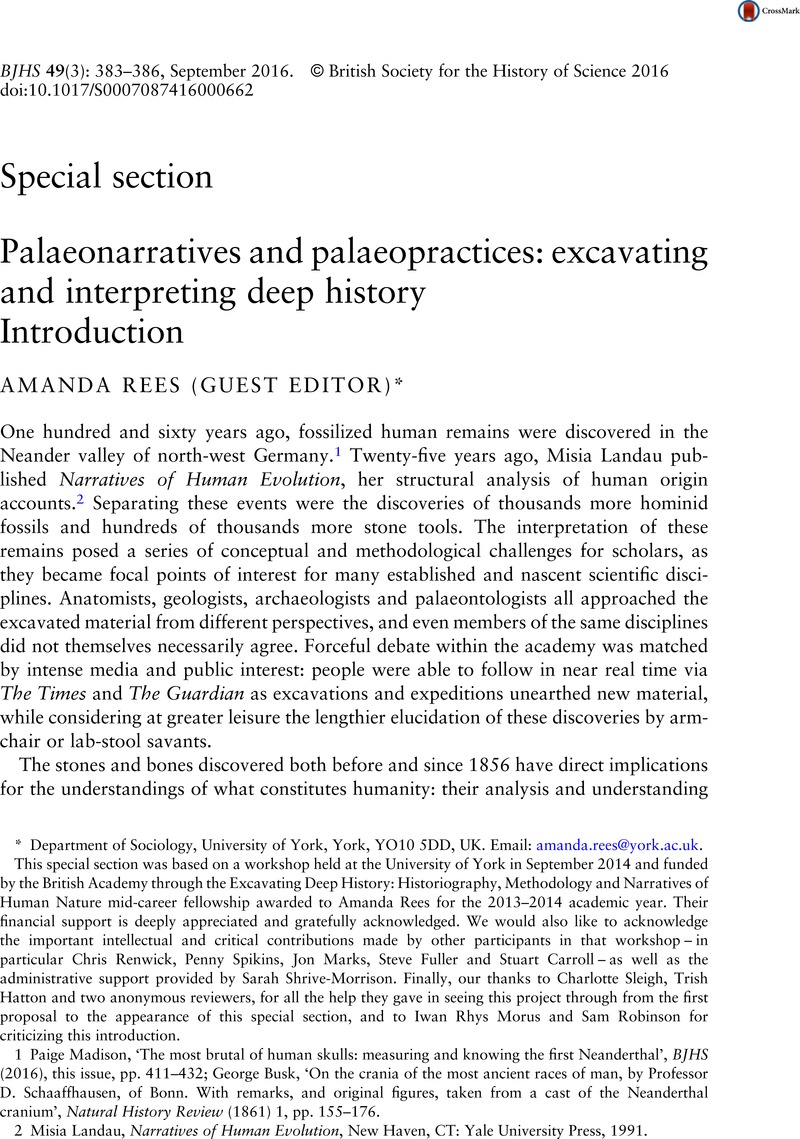No CrossRef data available.
Article contents
Introduction
Published online by Cambridge University Press: 10 October 2016
Abstract

- Type
- Special Section: Palaeonarratives and Palaeopractices: Excavating and Interpreting Deep History
- Information
- The British Journal for the History of Science , Volume 49 , Issue 3 , September 2016 , pp. 383 - 386
- Copyright
- Copyright © British Society for the History of Science 2016
References
1 Madison, Paige, ‘The most brutal of human skulls: measuring and knowing the first Neanderthal’, BJHS (2016), this issue, pp. 411–432 CrossRefGoogle ScholarPubMed; Busk, George, ‘On the crania of the most ancient races of man, by Professor D. Schaaffhausen, of Bonn. With remarks, and original figures, taken from a cast of the Neanderthal cranium’, Natural History Review (1861) 1, pp. 155–176 Google Scholar.
2 Landau, Misia, Narratives of Human Evolution, New Haven, CT: Yale University Press, 1991 Google Scholar.
3 Manias, Chris, ‘ Sinanthropus in Britain: human origins and international science, 1920–1939’, BJHS (2015) 48(2), pp. 289–319 Google Scholar; Goodrum, Matthew, ‘Crafting a new science: defining paleoanthropology and its relationship to prehistoric archaeology’, Isis (2014) 105, pp. 706–733 Google Scholar; Goodrum, , ‘The history of human origins research and its place in the history of science: research problems and historiography’, History of Science (2009) 47, pp. 337–357 Google Scholar; Corbey, Raymond and Roebroeks, Wil (eds.), Studying Human Origins: Disciplinary History and Epistemology, Amsterdam: Amsterdam University Press, 2001 Google Scholar; Golden, Murray, ‘Hobbits, hunters and hydrology: images of a “missing link” and its scientific communication’, Public Understanding of Science (2013) 22(50), pp. 575–589 Google Scholar.
4 Daniel, Glyn, The Idea of Prehistory, London: Penguin, 1962 Google Scholar; Chippindale, Christopher, ‘The invention of words for the idea of “prehistory”’, Proceedings of the Prehistoric Society (1988) 54, pp. 304–314 Google Scholar; Clermont, Norman and Smith, Philip E.L., ‘Prehistoric, prehistory, prehistorian, who invented the terms’, Antiquity (1990) 64, pp. 97–102 Google Scholar; Van Riper, A. Bowdoin, Men among the Mammoths: Victorian Science and the Discovery of Prehistory, Chicago: The University of Chicago Press, 1993 Google Scholar; Rowley-Conwy, Peter, ‘The concept of prehistory and the invention of the terms “prehistoric” and “prehistorian”: the Scandinavian origin, 1833–1850’, European Journal of Archaeology (2006) 9, 103–130 Google Scholar; Goodrum, Matthew, ‘The idea of human prehistory: the natural sciences, the human sciences and the problem of human origins in Victorian Britain’, History and Philosophy of the Life Sciences (2012) 33, pp. 117–145 Google Scholar.
5 Clark, Constance A., God or Gorilla: Images of Evolution in the Jazz Age, Baltimore: Johns Hopkins University Press, 2008 CrossRefGoogle Scholar; Clarke, , ‘“You are here”: missing links, chains of being and the language of cartoons’, Isis (2009) 100, pp. 571–589 Google Scholar; Moser, Stephanie, Ancestral Image: The Iconography of Human Origins, Ithaca, NY: Cornell University Press, 1998 Google Scholar; Berman, Judith C., ‘Bad hair days in the Paleolithic: modern (re)constructions of the cave man’, American Anthropologist (1999) 101, pp. 288–304 CrossRefGoogle Scholar; McCown, Theodore D. and Kennedy, Kenneth A.R., Climbing Man's Family Tree: A Collection of Major Writings on Human Phylogeny, 1699–1971, Englewood Cliffs, NJ: Prentice-Hall, 1972 Google Scholar.
6 de Bont, R., ‘The invention of prehistoric man: Aimé Rutot and the eoliths controversy, 1900–1920’, Isis (2003) 94, pp. 604–630 Google Scholar; Spencer, Frank, ‘Prologue to a scientific forgery: the British eolithic movement from Abbeville to Piltdown’, in Stocking, George (ed.), Bones, Bodies, Behaviours: Essays in Behavioural Anthropology, Madison: University of Wisconsin Press, 1990, pp. 84–116 Google Scholar.
7 Kjaergaard, Peter, ‘The fossil trade: paying a price for human origins, Isis (2012) 103, pp. 340–355 Google Scholar; Goodrum, Matthew and Oleson, Cora, ‘The quest for absolute chronology in human prehistory: anthropologists, chemists and the fluorine dating method in palaeoanthropology, BJHS (2009) 42(1), pp. 95–114 Google Scholar; Sommer, Marianne, Bones and Ochre: The Curious Afterlife of the Red Lady of Paviland, Cambridge, MA: Harvard University Press, 2008 Google Scholar.
8 Landau, Misia, ‘Human evolution as narrative’, American Scientist (1984) 72, pp. 262–268 Google Scholar. See also Eldredge, Niles and Tattersall, Ian, The Myths of Human Evolution, New York: Columbia University Press, 1982 Google Scholar; Bowler, Peter, Theories of Human Evolution: A Century of Debate, 1844–1944, Oxford: Blackwell, 1986 Google Scholar.
9 Ruddick, Nicholas, The Fire in the Stone: Prehistoric Fiction from Charles Darwin to Jean M. Auel, Middletown, CT: Wesleyan University Press, 2009 Google Scholar; de Paolo, Charles, Human Prehistory in Fiction, Jefferson, NC: McFarland & Co., 2002 Google Scholar; Sommer, Marianne, ‘The lost world as laboratory: the politics of evolution between science and fiction in early twentieth-century America’, Configurations (2007) 15(3), pp. 299–329 Google Scholar.
10 Bowler, Peter, ‘From “savage” to “primitive”: Victorian evolutionism and the interpretation of marginalised peoples’, Antiquity (1992) 66, pp. 721–729 Google Scholar; Stephan, Nancy, The Idea of Race in Science: Great Britain 1800–1960, London: Macmillan, 1982 Google Scholar; Stocking, George W., Victorian Anthropology, New York: The Free Press, 1987 Google Scholar; Livingstone, David N., Adam's Ancestors: Race, Religion and the Politics of Human Origins, Baltimore: Johns Hopkins University Press, 2008 Google Scholar; Delisle, R.G., ‘Welcome to the twilight zone: a forgotten early phase of human evolutionary studies’, Endeavour (2012) 36(2), pp. 55–64 Google Scholar; Gamble, Clive and Moutsiou, Theodora, ‘The time revolution of 1859 and the stratification of the primeval mind’, Notes and Records of the Royal Society (2011) 65, pp. 43–63 Google Scholar; Pettit, Paul B. and White, Mark J., ‘Cave men: stone tools, Victorian science and the “primitive mind” of deep time’, Notes and Records of the Royal Society (2011) 65, pp. 25–42 Google Scholar; Barany, Michael J., ‘Savage numbers and the evolution of civilisation in Victorian prehistory’, BJHS (2014) 47(2), pp. 239–255 Google Scholar.




